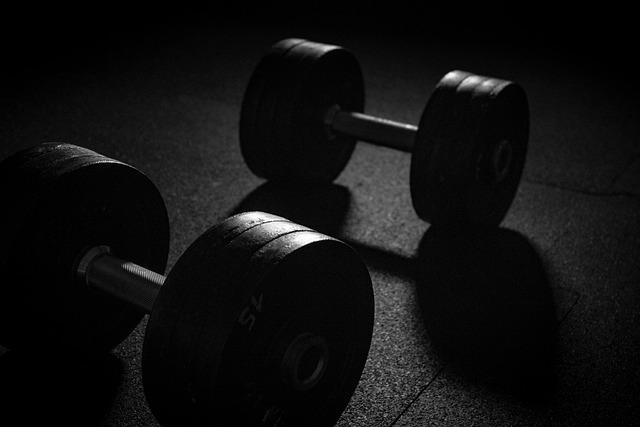Building full-body strength is an essential component of a balanced fitness regimen, and dumbbells are a versatile tool that can help you achieve this goal efficiently. Whether you’re a beginner stepping into the world of strength training or an experienced lifter looking to enhance your routine, incorporating dumbbells can elevate your workouts to new heights. In this guide, we will walk you through the fundamental principles of using dumbbells to develop robust, functional strength across your entire body. With a focus on proper form, balanced routines, and progressive overload, you’ll learn how to harness the power of dumbbells to sculpt and strengthen your muscles effectively. Prepare to embark on a transformative journey that will not only enhance your physical capabilities but also boost your confidence and overall well-being.
Choosing the Right Dumbbell Weight for Optimal Strength Gains
When embarking on your strength-building journey, selecting the appropriate dumbbell weight is crucial to maximizing your results and preventing injury. To begin, consider your current fitness level and the muscle group you intend to target. For beginners, it’s advisable to start with lighter weights, typically between 5-15 pounds, allowing your body to adapt to new movements and techniques. As you grow more comfortable, gradually increase the weight to challenge your muscles further.
- Assess Your Strength: Perform a set of 8-12 reps with your chosen weight. If you can’t complete the reps, reduce the weight; if it’s too easy, increase it.
- Focus on Form: Proper technique should always take precedence over lifting heavier weights.
- Adjust for Different Exercises: Your biceps might handle heavier weights than your triceps, so adjust accordingly.
Remember, the right dumbbell weight will make your workout both effective and safe. Listen to your body and adjust as needed to keep progressing towards your strength goals.

Mastering Fundamental Dumbbell Exercises for Full Body Engagement
Unlocking the potential of dumbbells involves more than just basic lifts; it requires a strategic approach to engage multiple muscle groups effectively. Dumbbell exercises are not only versatile but also crucial for building comprehensive strength. Here are some fundamental movements to incorporate into your routine:
- Goblet Squats: Holding a dumbbell close to your chest, perform squats to target your quads, glutes, and core. This exercise enhances lower body strength while promoting balance.
- Dumbbell Deadlifts: Engage your hamstrings, glutes, and lower back by lifting a pair of dumbbells from the ground. Focus on maintaining a neutral spine to avoid injury.
- Shoulder Press: Elevate dumbbells overhead to strengthen your shoulders and upper arms. This movement is essential for developing upper body power.
- Renegade Rows: Combine a plank with a rowing motion to engage your back, shoulders, and core. This exercise is perfect for enhancing stability and strength.
Incorporating these exercises into your workout regimen ensures a balanced development of strength across your entire body. Remember, proper form is key to maximizing benefits and minimizing risks.
Designing a Balanced Dumbbell Workout Routine for Maximum Effectiveness
Crafting a well-rounded dumbbell workout routine requires a strategic approach to ensure all major muscle groups are engaged and challenged. A balanced routine not only enhances muscle growth but also improves functional strength and overall fitness. Begin by incorporating exercises that target the upper body, such as bicep curls, tricep extensions, and shoulder presses. These movements build foundational strength and improve arm and shoulder endurance.
For the lower body, include exercises like squats, lunges, and deadlifts. These compound movements are crucial for building leg strength and stability. Don’t forget to incorporate core exercises such as Russian twists and plank rows to ensure a strong midsection. To maximize effectiveness, consider the following tips:
- Perform each exercise with proper form to prevent injury and maximize gains.
- Vary the weight and repetitions to continuously challenge your muscles.
- Include a mix of both compound and isolation exercises for comprehensive strength development.
- Allow adequate rest between sets and workouts to facilitate muscle recovery.
By thoughtfully designing your dumbbell workout routine, you ensure a balanced approach to full-body strength training.
Incorporating Progressive Overload Techniques to Enhance Strength Building
To effectively boost your full body strength using dumbbells, integrating progressive overload techniques is essential. This method involves gradually increasing the demands placed on your muscles to continually challenge them, fostering growth and improvement. Here’s how you can implement this strategy into your workouts:
- Incremental Weight Increases: Start with a weight that you can lift comfortably for your desired number of repetitions. Gradually increase the weight as you build strength. This ensures your muscles are constantly adapting to new challenges.
- Higher Repetitions: Once you’ve mastered a certain weight, aim to increase the number of repetitions. This not only enhances muscular endurance but also sets the stage for future weight increments.
- Enhanced Frequency: Increase the frequency of your workouts by adding an extra session each week. This allows your muscles to adapt more quickly to the increased workload.
By implementing these techniques, you’ll notice significant improvements in your strength and overall muscle development. Remember, consistency is key, and tracking your progress will help you stay motivated and focused on your goals.




